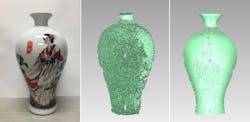Simple dynamic structured-light sensing system shows dense point cloud
Often used for 3D acquisition for face recognition—for example, in the iPhone X by Apple—structured light scanning (SLS) has other uses as well in virtual reality, animation, and industrial inspection. SLS techniques are undergoing constant improvement, as evidenced by an infrared (IR) SLS system for dynamic 3D acquisition with improved accuracy developed by researchers at Shenzhen Institutes of Advanced Technology (SIAT; Shenzhen, China), the University of Chinese Academy of Sciences (Beijing, China), and the Chinese University of Hong Kong.
A typical SLS system consists of a camera and a projector that overlays a structured-light pattern on the objects to be characterized; a decoding method is adopted to extract the pattern feature from the captured images and establish correspondences between the camera and the projector. Using a stripe-based pattern, the SIAT scientists based their algorithm on the so-called Gray code, a time-multiplexing technique that removes periodic ambiguities, combining it with line-shifting to achieve subpixel correspondence mapping; they used IR light, as it is noninvasive. A MEMS-based digital light processor (DLP) projector was combined with a BFS-U3-04S2M camera by FLIR Systems (Wilsonville, OR) and an IR narrowband filter with a wavelength of 850 nm, which makes the system insensitive to ambient light. Live video images are captured at a 29 Hz frame rate. To assure that the SLS system could work at the maximum capture speed, the team parallelized the decoding algorithm on the system's GPU; results showed that the new algorithm reduced decoding time from 1.5 s to 0.5 ms. A quick and accurate calibration method for the system was developed based on a printed chessboard pattern.
When compared to the Intel RealSense D435 stereo-vision-based 3D camera and Microsoft's Kinect v2 time-of-flight 3D image sensor, the SIAT system showed denser and more-accurate information. In a test comparing the new system to a similar SLS system, but with LED illumination and no filter, images of a china vase (left) at the same distance and location were captured with SLS based on LED light (center) and with the IR SLS system (right), showing significantly better performance for the latter system. The researchers have a goal of reducing the size of their sensor to that of the Intel RealSense sensor. Reference: Y. Ye et al., Appl. Opt. (2020); https://doi.org/10.1364/ao.388483.
About the Author
John Wallace
Senior Technical Editor (1998-2022)
John Wallace was with Laser Focus World for nearly 25 years, retiring in late June 2022. He obtained a bachelor's degree in mechanical engineering and physics at Rutgers University and a master's in optical engineering at the University of Rochester. Before becoming an editor, John worked as an engineer at RCA, Exxon, Eastman Kodak, and GCA Corporation.

